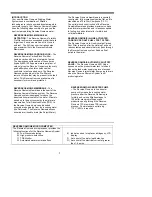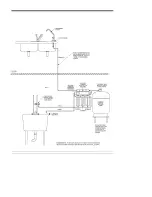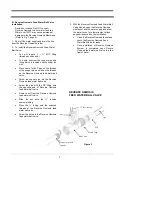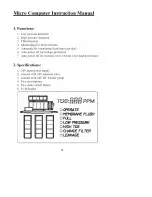
REVERSE OSMOSIS OPERATION &
MAINTENANCE
A. Reverse Osmosis Normal Operation
1. Reverse Osmosis systems produce
drinking water at relatively slow rates.
Normal operation is to let the Reverse
Osmosis Holding Tank fill with water and
then draw water as is needed. When the
pressure in the Reverse Osmosis Holding
Tank falls to a given pressure (as the water
is being used) the Automatic Shut-Off
Valve (ASO Valve) will start water
production and the Reverse Osmosis
system will refill the Re4verse Osmosis
Holding Tank. When the Reverse Osmosis
Holding Tank is full and no water is being
used, the ASO Valve will automatically shut
off the feed water to conserve water. The
more water that is used (up to the capacity
of the system) the better the Reverse
Osmosis system will function.
After periods of non-use, such as a week
of vacation, it is better to empty the
Reverse Osmosis Holding Tank and allow
the Reverse Osmosis system to produce
fresh water for use. If the Reverse
Osmosis system is not used for 3-4 weeks
or longer, it is a good idea to re-sanitize the
Reverse Osmosis system and to change
the Reverse Osmosis pre-filter and post
filters.
B. Reverse Osmosis Changing Filters
THIS REVERSE OSMOSIS SYSTEM
CONTAINS REVERSE OSMOSIS FILTERS
WHICH MUST BE REPLACED AT
REGULAR INTERVALS TO MAINTAIN
PROPER PERFORMANCE. USE ONLY
FACTORY APPROVED FILTERS.
The recommended interval for changing the
Reverse Osmosis filters (not the Reverse
Osmosis Membrane) is every six (6) months.
Typical T.F.C. Reverse Osmosis Membrane
life expectancy is Five to ten years with
Water Softener prior to Reverse Osmosis
system. Local conditions may dictate more
frequent changes.
1. Close the Reverse Osmosis Feed Water Ball
Valve by turning fully clockwise and open the
Re4verse Osmosis Dispensing Faucet by
lifting the handle. Allow the REverse
Osmosis Holding Tank to empty.
2. Loosen and remove the Reverse Osmosis
Sediment Pre-filter and the Activated Carbon
Pre-filter Housings. Wash the inside of the
Reverse Osmosis Housings using a mild
detergent and a soft cloth. Do not use
abrasive cleaners or pads. Thoroughly rinse
all soap from the Reverse Osmosis
Housings before reassembly.
3. To sanitize the Reverse Osmosis system
and replace the Reverse Osmosis filters:
NOTE:
The Reverse Osmosis system should
be sanitized before installing the Reverse
Osmosis Activated Carbon Pre-filter.
•
Use a good quality unscented liquid
chlorine household bleach.
•
Add one capful Reverse Osmosis
Sediment Pre-filter Housing and install the
Reverse Osmosis Housing O-ring for
proper position in its groove, engage and
firmly tighten the Housing hand tight only.
•
Add one capful of bleach to the
Reverse Osmosis Activated Carbon Pre-
filter Housing. Install the Reverse Osmosis
Housing without the Reverse Osmosis
Activated Carbon Pre-filter.
•
The Reverse Osmosis Dispensing Faucet
should be open, slowly open the Reverse
Osmosis Feed Water Ball Valve.
•
As soon as the water begins to drip out of
the Dispensing Faucet, close the Faucet.
•
Let the Reverse Osmosis system stand for
15 minutes.
•
At the end of 15 minutes, in the following
order, close the Reverse Osmosis Feed
Water Ball Valve, close the Reverse
Osmosis Holding Tank Valve and open the
Dispensing Faucet to release the pressure.
•
Remove the Reverse Osmosis Activated
Carbon Pre-filter Housing and empty.
Remove the wrapping and install the
Reverse Osmosis Activated Carbon Pre-
filter. Firmly tighten the Reverse Osmosis
Housing hand tight only.
•
Disconnect the Reverse Osmosis tubing
that runs from the Reverse Osmosis
Holding Tank to the Tee (see Fig. 1, page
3). Put 50 drops of bleach (this is ½ tsp. or
10
Summary of Contents for EWR 4050
Page 5: ...BALL...
Page 8: ...LONG REACH FAUCET Figure 2A 6...
Page 14: ...12...
Page 15: ...13...
Page 16: ...14...
Page 17: ...15...
Page 18: ...16...
Page 19: ...17...
Page 20: ...18...
Page 23: ...21 Formatted Bottom 0 5...









































